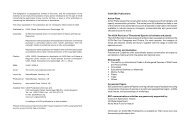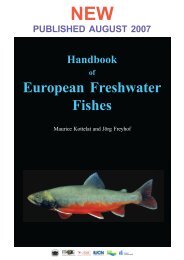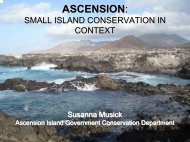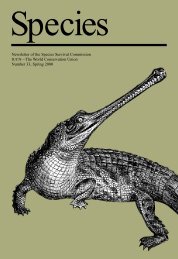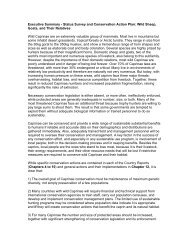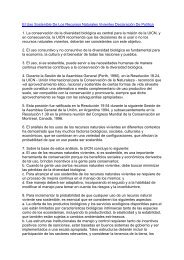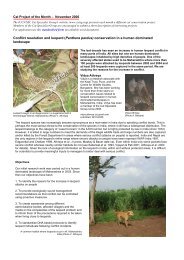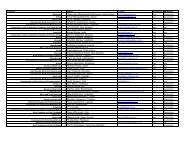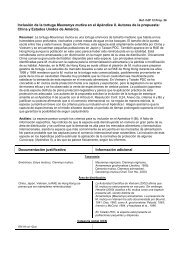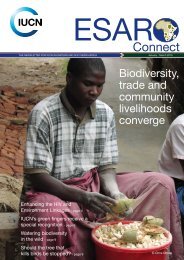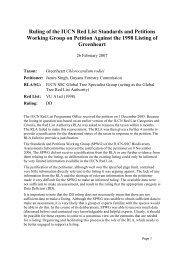Planning education to care for the earth - IUCN Knowledge Network
Planning education to care for the earth - IUCN Knowledge Network
Planning education to care for the earth - IUCN Knowledge Network
You also want an ePaper? Increase the reach of your titles
YUMPU automatically turns print PDFs into web optimized ePapers that Google loves.
<strong>Planning</strong> <strong>education</strong> <strong>to</strong> <strong>care</strong> <strong>for</strong> <strong>the</strong> <strong>earth</strong>•community <strong>education</strong>, planning, <strong>the</strong> role of professional institutes,rural and urban studies, nature conservation, and leisure activities;•Participation in workshops and conferences arranged by o<strong>the</strong>r bodies,in some cases organized as a means of channelling opinions <strong>to</strong> <strong>the</strong>Working Group e.g. on development <strong>education</strong> and values <strong>education</strong>.These initiatives produced a great deal of material and created much interestat a time of change, <strong>for</strong> example in <strong>the</strong> structure and functions of majorenvironmental organizations, <strong>the</strong> school curriculum, <strong>the</strong> organization andfunding of higher <strong>education</strong>, <strong>the</strong> environmental sensitivity of business andindustry, and <strong>the</strong> development of environmental charters.Workshops and seminars were perhaps <strong>the</strong> most rewarding experience. Theparticipants represented a wide range of interests - from senior civil servantsand academic figures <strong>to</strong> organizers of local play groups and youthorganizations. They welcomed <strong>the</strong> opportunity <strong>to</strong> discuss shared concernswith people <strong>the</strong>y might never have had <strong>the</strong> occasion <strong>to</strong> meet previously.These ga<strong>the</strong>rings established new contacts and generated new initiatives.One of <strong>the</strong> working group’s most useful outcomes might be <strong>to</strong> provide amechanism <strong>for</strong> continuing this <strong>for</strong>m of activity beyond its own lifetime.The Working Group divided its activities among a number of sub-groupsrepresenting <strong>the</strong> different fields of learning experience through which peoplepass, ra<strong>the</strong>r than a more conventional approach based on <strong>the</strong> providers of<strong>education</strong>. This was a rewarding and stimulating initiative. Six of <strong>the</strong> subgroupsrepresented respectively : home; community; school; post-school<strong>education</strong>; workplace; and recreation and leisure. Two more sub-groups dealtwith external influences: <strong>the</strong> media, entertainment and advertising; andpolicy-makers in national and local government and elsewhere.Each sub-group was convened by a member of <strong>the</strong> working group butincluded outsiders, thus extending <strong>the</strong> range of expertise and <strong>the</strong> number ofpeople with a stake in <strong>the</strong> final conclusions and recommendations. Each subgroupadopted its own way of working, some by enlarging <strong>the</strong> group, o<strong>the</strong>rsby setting up interviews and workshops. A set of reports from <strong>the</strong> sub-groupswas presented <strong>to</strong> a conference attended by many of <strong>the</strong> interested parties.The discussion of <strong>the</strong> reports produced much advice helpful in <strong>the</strong> draftingof <strong>the</strong> Working Group’s final report.In its final stages <strong>the</strong> draft report of <strong>the</strong> Working Group was taken <strong>to</strong> some of<strong>the</strong> major bodies in <strong>the</strong> public and private sec<strong>to</strong>rs which would be involvedin implementation <strong>for</strong> comments on its practicability. All were positive andencouraging.The final report has four main chapters and several annexes. It begins with anintroduction <strong>to</strong> environmental <strong>education</strong> in Scotland, and continues with areview of current activities by category, <strong>for</strong> example, national and localgovernment, schools and post-school <strong>for</strong>mal <strong>education</strong>, industry, <strong>the</strong> urbanand rural sec<strong>to</strong>rs, and voluntary organizations. A fur<strong>the</strong>r chapter assessespresent needs and prospects as outlined by <strong>the</strong> sub-groups in differentlearning contexts. Recommendations <strong>for</strong> a strategy occupy <strong>the</strong> final chapter.114



